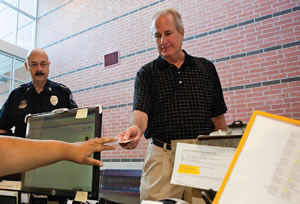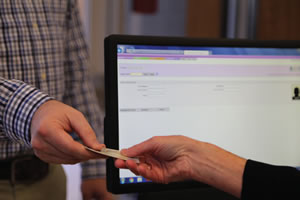All Visitors Must Sign In

PHOTO COURTESY OF RAPTURE TECHNOLOGIES
When developing security
measures for school buildings,
facility planners and administrators
work hard to avoid visual references
to correctional facilities. Any perception
that they have gone too far with fencing,
metal detectors or surveillance cameras
typically generates an automatic response
of, “we cannot operate our schools like
prisons!” The learning environment we
create for teachers and children is simply
not the same as the space necessary for
locking up criminals. Still, if the comparison
sets an obvious boundary for the
design and operation of school facilities, it
does remind us that at least in prisons it is
possible to have absolute control over individuals
entering or exiting the building.
Keeping our schools safe would be much
simpler if we allowed only the children and
the people who work there to have access to
the campus and the buildings. This is not
the case. During the course of any school
day, a variety of people have legitimate
reasons to come inside, and many are there
to interact with students. Parents are delivering
forgotten items. Volunteers from the broader community are participating in the
instructional program. Vendors are making
sales calls or providing contracted services.
Maintenance technicians, consultants and
contractors are routinely in the school to
perform work related to the buildings and
grounds. Keeping up with exactly who is
coming and going at times seems almost impossible.
If an incident occurs in a school that
is the result of someone with ill intent gaining
access, the immediate question is “why were
they allowed to enter the building?”

PHOTO COURTESY OF RAPTURE TECHNOLOGIES
ID please. Most schools have a number of visitors every day for many different reasons. The first
step in ensuring a secure facility is to make sure that visitors can only enter the buildings through
entrances that are monitored. In order to protect the students and the staff from harm or disruptions,
administration and security personnel need to know who is coming and going at all times. There are
a number of visitor management systems currently being used that not only verify identification, but
also run background checks of visitors.
Identification
At a minimum, most schools have signs
posted around campus requiring visitors
to report to the office prior to entering
the school and sign-in. Technology has
stepped in with kiosk style sign-in stations
requiring visitors to enter information on a
computer, which prints a photo ID badge to
be worn while on campus. School staff are
instructed to notify the office of any visitors
or strangers on campus not displaying
the proper credentials.
Innovations with automated visitor
management systems now include scanning
a driver’s license or government issued
ID as part of the sign in process. The
system quickly compares data from the ID
against registered sex offender databases
in 50 states. Jim Vesterman, CEO of Rapture
Technologies states, “on average we
flag 35 registered sex offenders a day, from
our current client base of 17,000 schools
across the country.” Some systems also
allow the screening process to compare the
visitor’s ID to a custom database indicating
child custody restrictions, barred parents,
known gang members, etc. Whether the
district chooses a visitor management
system that performs one or both of the
database screening processes, it all occurs
in a matter of seconds.
Access Control
School buildings are compelled to
provide an abundance of exterior entrances
to in order to meet fire code requirements
for egress. During the school day it becomes
a challenge to ensure doors are not left open
or unlocked to prevent unauthorized entry. Attempting to keep all exterior doors secure
during the day in older schools with traditional
key systems can be difficult to manage.
Alternative locking systems such as card
access or automated access offer a tremendous
advantage, particularly insuring that
only authorized staff members are provided
entry access. A primary benefit of automated
access is that an audit trail is established detailing
exactly who opened which door along
with the exact time it was opened.
Concerning interior doors, there is
an argument to be made for classroom
doors always being locked, particularly
when the room is occupied by students.
Schools equipped with automated access
systems have an advantage in being able
to remotely monitor where doors are not
properly secured. Following the Sandy
Hook Elementary school shooting there
were a variety of products introduced for
providing additional security on interior
doors during lock-down. In most cases
these solutions were found to be unsuitable
due to fire codes and potentially preventing
authorized access in emergencies.

PHOTO COURTESY OF RAPTURE TECHNOLOGIES
Security vestibules are a relatively new
design element for school facilities. Once
the final bell rings each morning, entrance
doors from the vestibule into the main
building are locked and visitors may only
enter the school through the main office
for the remainder of the day. Entrances for
older, existing facilities can be retrofitted
with security vestibules. In some cases,
schools have been equipped with a CCTV
camera at the front door and a “buzz-in”
latch operated by main office staff. This arrangement
is less effective because it allows
access into the building before the identity
of the visitor has been verified.
Surveillance
A key to identifying unauthorized
individuals on school campuses is training
all staff members to question visitors that
are not displaying proper identification
issued from the main office. If the visitor
is acting suspiciously or raises any level
of concern, the staff member should take
steps to notify appropriate administrative
staff or security personnel. For a variety
of reasons this does not always occur.
It is not uncommon for those that frequently
visit schools in the course of their
work, to enter any open door at a school
and wander about freely without anyone
questioning their presence. Sometimes the
staff becomes complacent. They assume a
well-dressed adult who appears to know
where they are and what they are doing is
not likely to pose a threat. With a properly
designed visitor management program in
place, anyone walking through a school
without visible evidence of authorization
from the main office should be questioned.
If for any reason there is a perceived threat,
it may be necessary to avoid confrontation
and quickly take steps to notify others.
Communications
There are a number of technologybased
solutions to enhance emergency
communications inside the building
as well as on the school grounds. Staff
members can make use of well-placed
phones, intercom stations, cell phones or
handheld two-way radios. Several of the
voice enhancement systems currently
utilized in the classroom involve a pendant
the teacher wears throughout the day. The
teacher can press a button on the pendant
that activates a built-in microphone, discretely
notifying appropriate personnel for
assistance. Additionally, school districts
have made a significant investment in
surveillance cameras most of which can be
accessed districtwide. If an unauthorized
visitor has been reported, the cameras may
prove useful, although the greatest benefit
has been found after an event to provide
visual evidence of the event.
The safety and wellbeing of children
in our schools is the highest priority for
school administrators, parents and the
community. It is everybody’s responsibility.
All the technology that money can buy
is no substitute for principals, teachers,
custodians, cafeteria staff and bus drivers
being constantly observant. We cannot
allow visitors to come on campus or enter
school buildings during the school day
without authorization. It is often said that
if someone with harmful intentions wants
to enter a school, they will find a way. We
should not make it easy for them.
About the Authors
Andrew LaRowe is president of EduCon Educational Consulting located in Winston Salem, N.C. He can be reached at [email protected]
Mike Raible is founder and CEO of The School Solutions Group in Charlotte, N.C., and the author of "Every Child, Every Day: Achieving Zero Dropouts Through Performance-Based Education". He can be reached at [email protected].